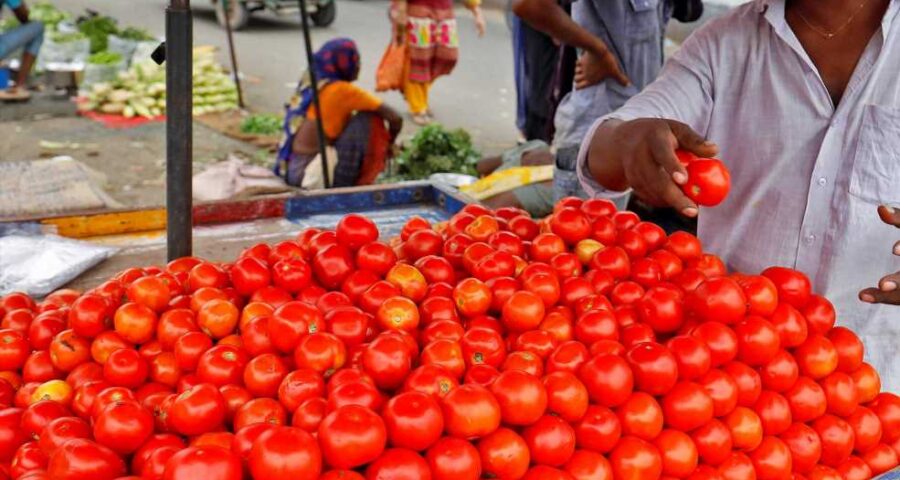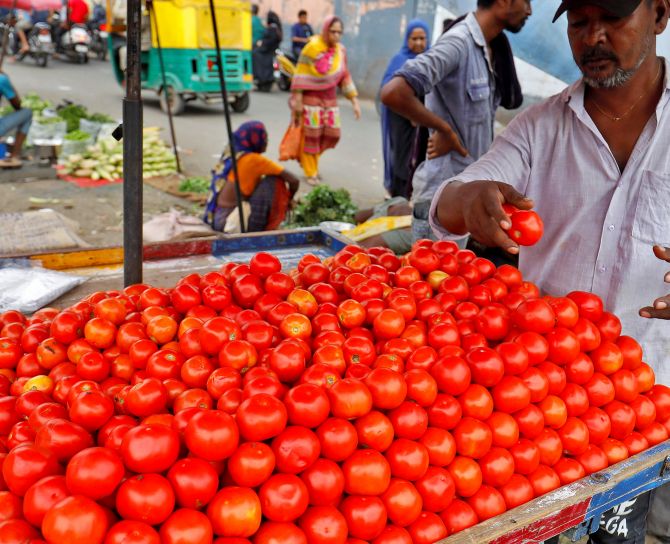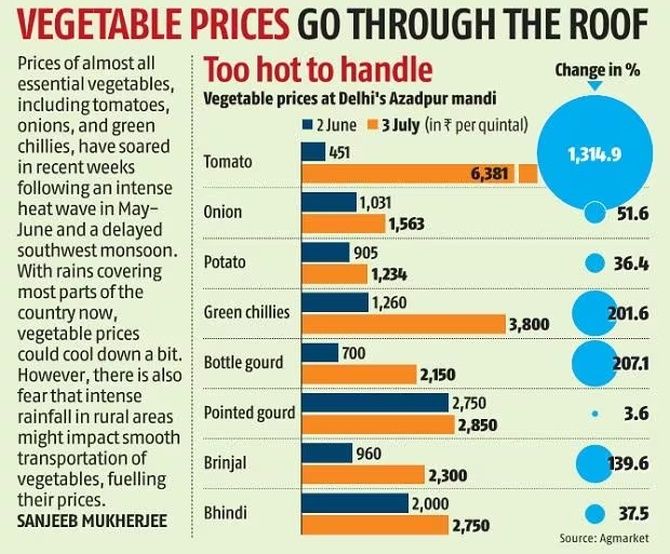8 out of 10 households are planning to cut their tomato consumption if prices stay in the Rs 75-150 kg range over the next three months.
Tomato prices have increased more than Rs 100 per kg in retail markets across India, pinching kitchen budgets of households.
The government has said that the price rise is temporary and would cool down in 15-30 days, but according to trade sources that might not happen that soon.
Tomato prices in Delhi’s Azadpur wholesale market have increased 1,315 per cent between June 2 and July 3, from Rs 451 a quintal to Rs 6,381 per quintal.
Arrivals have dropped by almost 40 per cent during the same period in Azadpur.
Supplies have dwindled as the crop was damaged in some main production regions: First due to a hailstorm in March and April and then a disease in Karnataka. It’s not the first time that tomato prices have jumped so sharply.
Tomatoes, onions and potatoes, which are commonly called TOP, have the sharpest fluctuation in prices in a year.
In March 2023, onion prices dropped so sharply down that farmers dumped their produce in open fields as they weren’t getting any return.
The Centre intervened to help farmers, but onion prices are rising and it won’t be surprising if they reach new levels in some weeks.
Similarly, also is the case with potatoes.
Tomato prices have increased due to multiple factors, but the prime among them is a heat wave in early June and pest attack on standing crop in Karnataka, a major producer.
Tomato is a short-duration crop and grown multiple times in a year at multiple locations.
Besides Karnataka, major production occurs in Madhya Pradesh, Andhra Pradesh, and Gujarat.
These states together comprise almost 48 per cent of India’s annual tomato production.
India is projected to produce around 20.62 million tonnes of tomatoes in 2022-23, or marginally less than last year.
June-August and October-November are lean seasons for tomatoes when prices rise.
In Karnataka, as per local media reports, arrivals in the Kolar APMC have dropped sharply as farmers aren’t getting adequate yields.
Yields have halved in Karnataka due to a virus called ‘tomato leaf curl’.
Some reports said that almost 50 per cent of the tomato crop in Karnataka has been infected by the virus.
With a big chunk of supplies affected due to the virus, reliance on supplies from other centres has risen.
Against a shelf life of around 72 hours, the virus-infected tomatoes start rotting in 45-50 hours.
Impact on consumers
The high prices of tomatoes are having a cascading impact on kitchen budgets where it is an integral part.
A survey conducted by Local Circles, a community social media platform, throws light on the pain high tomato prices are causing.
It found that almost 77 per cent of households surveyed confirmed paying over Rs 50 a kilogram for tomatoes and almost 32 per cent of them paid over Rs 80 per kg.
The survey said that almost 8 out of 10 households are planning to cut their tomato consumption if prices stay in the Rs 75-150 kilogram range over the next three months.
Local Circles was conducted a few weeks back among almost 21,000 respondents in 309 districts of the country.
The response
The central government has said that tomato prices will come down in due course.
‘I am not justifying the rate. This also proves seasonality. It’s a complex problem,’ Consumer Affairs Secretary Rohit Kumar Singh recently told reporters as per a report published in PTI.
The Centre has also announced a hackathon to get ideas to deal with the recurring crisis in tomatoes, something which it had done for some other crops as well.
However, experts said more than the complexity of the problem it is the inadequate and half-hearted attempts being made by successive governments to handle the problem in TOP.
Agriculture economist Ashok Gulati wrote in a newspaper article that to bring down inflation in tomatoes the Centre should ensure that at least 10 per cent of the annual production is processed into purees which can be stored and used any time. The GST on processed tomatoes needs to be lowered.
Secondly, he advocated lowering of the supply chain intermediaries through quick reforms in the agriculture marketing space and thirdly extensive promotion of farming practices that improve tomato yields and reduce the chance of diseases.
The Union Budget 2018-2019 launched a scheme called Operation Greens with an outlay of Rs 500 crore (Rs 5 billion). The scheme’s objective was to stabilize the supply of TOP crops and control its price volatility.
The scheme has multiple components that include the ministry of food processing providing a 50 per cent of the subsidy, through NAFED, transporting TOP crops from production to storage and hiring of appropriate storage facilities for these crops.
The long-term objectives of the scheme are enhancing value realization of farmers by targeted interventions to strengthen production clusters and FPOs and linking the farmers with the market.
It also aims to reduce post-harvest losses by the creation of farm gate infrastructure, development of suitable agriculture logistics, creation of appropriate storage capacity linking consumption centres and increasing food processing capacities and value addition in the value chain by creating firm linkages with identified production clusters.
As per data furnished on the food processing ministry’s Web site till May 2023, almost 46 projects worth around Rs 2,300 crore are under various stages of implementation and they have an eligible grant of around Rs 571 crore.
India’s horticulture production in 2022-2023 reached an all-time high of more than 350 million tonnes. It surpassed food grains and cereals production by a long way.
As per some reports, up to 12-16 per cent of the fruits and vegetables India produces is wasted annually.
The total post-harvest losses of agriculture commodities was estimated at about Rs 44,000 crores (Rs 440 billion) at 2009 wholesale prices.
Stopping this wastage could be another way to boost supplies.
Feature Presentation: Rajesh Alva/Rediff.com
Source: Read Full Article




